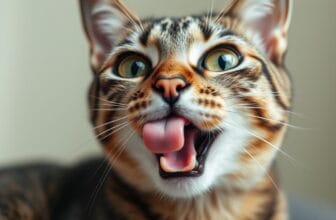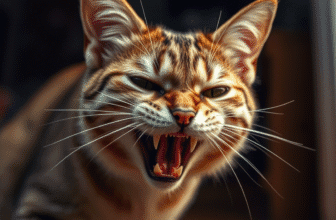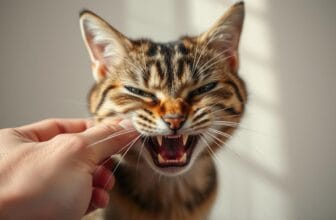
Table of Contents
Have you ever caught your pet sniffing, pawing, or even tasting substances in their bathroom zone? This puzzling habit might leave you wondering: Is this normal, or a hidden cry for help?
Many owners notice their furry companions interacting oddly with clay or silica pellets. While kittens often explore textures out of curiosity, repeated snacking could signal pica—a condition driving animals to eat non-food items. This behavior isn’t just quirky—it might reveal nutritional gaps or health problems.
Younger pets sometimes nibble litter during playful phases. But adults doing this regularly? That’s a red flag. Digestive troubles, anemia, or even stress could fuel this habit. The type of litter matters too—clumping varieties pose bigger risks if swallowed.
In this guide, you’ll discover:
- How to distinguish curiosity from compulsive behavior
- Health conditions linked to unusual snacking habits
- When to consult your veterinarian
Patterns matter. Tracking how often and intensely your pet engages with their bathroom materials helps identify emergencies. Let’s decode what’s really happening in that litter zone.
Understanding the Behavior and Its Causes
Why do some pets develop strange cravings for non-food items? Young animals often explore their world through taste—kittens might sample unfamiliar textures like clay pellets during playful investigation. This phase usually fades as they mature, but persistent nibbling warrants attention.
Curiosity, Play, and Early Learning
Newborns learn by interacting with their surroundings. A fluffy companion batting at silica grains or sniffing corn-based materials could simply test boundaries. Studies show 23% of young pets outgrow this habit within six months when given safe alternatives.
Behavioral Patterns and Pica
Repetitive snacking on indigestible substances often signals pica. Stress, boredom, or unmet nutritional needs might drive this compulsion. For example, iron-deficient animals sometimes seek minerals in unconventional places—like clay-based bathroom substrates.
Dietary and Nutritional Influences
Low-quality meals lacking essential nutrients can trigger unusual cravings. If your pet’s food lacks taurine or fiber, they might turn to grass-seed litters for roughage. Even scented varieties mimicking food aromas—like wheat or alfalfa—could accidentally encourage tasting.
Environment matters too. A cramped or poorly maintained bathroom area may stress animals, amplifying odd behaviors. Regular vet checkups help rule out deficiencies while ensuring balanced diets meet all needs.
Cat Licking the Litter Box: Recognizing Health and Toxicity Concerns
What starts as odd snacking could mask critical health alarms. Persistent consumption of bathroom substrate often points to deeper issues requiring immediate attention. Let’s break down the red flags every owner should recognize.

Identifying Signs of Litter Toxicity
Watch for vomiting, diarrhea, or sudden lethargy—these signal possible chemical exposure. Dust from clumping litter may trigger wheezing or nasal irritation when inhaled. Silica crystals or synthetic additives can irritate digestive linings, causing bloody stools.
Respiratory distress often appears first. If your pet coughs after using their bathroom area, switch to low-dust alternatives immediately. Track symptoms using a 48-hour journal to share with your vet.
Common Health Conditions and Underlying Diseases
Chronic snacking might indicate anemia, where low red blood cells drive cravings for iron-rich minerals. Kidney disease also correlates with unusual eating habits—toxin buildup disrupts normal appetite patterns.
Blockages from ingested materials are emergencies. Clay-based products expand in intestines, creating life-threatening obstructions. Annual blood tests help detect organ issues early, especially in older pets.
- Pale gums or rapid breathing (anemia indicators)
- Increased thirst or weight loss (kidney disease signs)
- Straining during bowel movements (blockage warning)
Never ignore repeated incidents. Schedule a veterinary visit if symptoms persist beyond 24 hours. Blood work and X-rays can uncover hidden conditions before they escalate.
Practical Solutions to Prevent and Manage Litter-Eating Habits
Tackling unusual snacking behaviors requires smart adjustments to daily routines and environments. Start by assessing your pet’s setup—small changes often yield big results.

Optimizing Maintenance and Material Choices
Scoop waste twice daily and replace substrates weekly. Dust-free, plant-based options like paper pellets or walnut shells reduce temptation. Avoid scented varieties—food-like aromas might confuse curious noses.
Nutrition and Environmental Tweaks
Upgrade meals to high-fiber formulas with vet-approved supplements. Puzzle feeders slow eating while satisfying foraging instincts. Rotate interactive toys weekly—feather wands or treat balls redirect attention during peak activity times.
Recognizing Emergency Signals
Persistent nibbling paired with vomiting indicates potential blockage risks. Track bathroom habits: straining or reduced appetite demands urgent vet visits. Professionals might recommend X-rays to check digestive tract health.
Schedule playtime before meals to burn energy. A 2023 ASPCA study found 15-minute daily sessions reduce compulsive behaviors by 40%. Always keep emergency clinic contacts visible for sudden issues.
Conclusion
When your furry friend starts showing unusual habits like tasting bathroom materials, it’s time to act. Cats eat litter for various reasons—curiosity in young cat kittens, nutritional gaps, or hidden health concerns. Recognizing these patterns early helps prevent risks.
Watch for key signs: sudden appetite changes, digestive issues, or repeated snacking. Your pet might crave minerals or fiber missing from their diet. Even playful exploration could escalate if not addressed.
Switch to safer litters like paper-based or cat grass blends. These options reduce toxicity risks while satisfying natural instincts. Always keep the area clean and monitor interactions closely.
If odd behaviors persist, your companion may also need professional care. Blood tests or dietary adjustments often resolve underlying causes. Trust your instincts—delayed action can worsen conditions.
Stay proactive. Track habits, choose litters wisely, and consult experts when red flags appear. Your vigilance ensures a healthier, happier life for your curious pet.
FAQ for cat licking the litter box
Could anemia or nutrient deficiencies cause this behavior?
Yes. Felines with low red blood cell counts or lacking essential minerals like iron may eat litter due to pica. This compulsion often signals underlying health issues, such as kidney disease or dietary imbalances. A vet can perform blood tests to check for anemia or deficiencies.
Is clumping clay litter dangerous if ingested?
Clumping litters expand when wet, posing risks of intestinal blockage if swallowed. Silica-based or biodegradable options like World’s Best Cat Litter are safer alternatives. Always monitor your pet and consult a vet if you suspect ingestion.
How does kidney disease relate to litter consumption?
Chronic kidney issues disrupt nutrient absorption, leading to unusual cravings. Pets might seek minerals in litter due to metabolic imbalances. Bloodwork and urinalysis help diagnose this condition, which requires tailored diets and veterinary care.
Can environmental changes reduce this habit?
Enriching your home with interactive toys, scratching posts, or cat grass distracts from litter exploration. Regular playtime and puzzle feeders also curb boredom-driven behaviors. Ensure the litter area is clean and separate from feeding zones.
When should I contact a veterinarian immediately?
Seek urgent care if your feline shows vomiting, lethargy, or constipation after litter exposure. These symptoms may indicate toxicity or obstruction. Early intervention prevents complications like bowel perforation or poisoning from litter additives.
Sources:
Why Is My Cat Eating Litter? – Hill’s Pet Nutrition
Why Is My Cat Eating Litter? – PetMD
Why Does My Cat Eat Litter? – Town & Country Veterinary Clinic







